| 1. |
Tractor can use: |
|
|
Wheels |
|
|
Tracks |
|
|
Wheels and tracks |
| 2. |
Articulated tractors are around |
|
|
20 hp |
|
|
250-500 hp |
| 3. |
Which one of the following functions was designed as primary function of a farm tractor? |
|
|
Load Mover (High Lift) |
|
|
Remote Power Source (PTO) |
|
|
Implement Carrier (3 Pt. Hitch) |
|
|
Transport Unit (Drawbar Hitch) |
|
|
All of the above |
| 4. |
Which one of followings are design elements of a tractor:
- Rear wheels adjustable for width
- "Turn-on-a-dime" steering
- High-powered engine with many gear ranges for relatively low speeds
- Great clearance beneath the tractor
- More weight over traction wheels
- Individual brakes for each rear wheel
- Adjustable drawbar hitch
- Power controls to increase pulling power
- Potential to add or subtract weights for ballast
- Hydraulic system for added power source
- PTO shaft to transfer power to towed a hitched machine
- Differential lock for added traction
- Adapted to carry or pull equipment
- Fitted with a Rollover Protective Structure (ROPS) or a Falling Object Protective Structure (FOPS)
|
|
|
1, 2, 4 and 7 |
|
|
2,5, 6, 10 and 11 |
|
|
All of the above |
| 5. |
Which one of the following hazards could be associated with tractor. |
|
|
Overturns |
|
|
Runovers |
|
|
Power Take-Off Entanglements |
|
|
Older Tractors |
|
|
All the above |
| 6. |
Tractor rollover is ________________ and accounts for _______ farm-work fatalities. |
|
|
One major hazard group the most |
|
|
the least hazard group the least |
| 7. |
Which one of the followings could cause common tractor overturns?
|
|
|
Turning or driving too close to the edge of a bank or ditch. |
|
|
Driving too fast on rough roads and lanes and running or bouncing off the road or lane. |
|
|
Hitching somewhere other than the drawbar when pulling or towing objects. |
|
|
Driving a tractor straight up a slope that is too steep. |
|
|
Turning a tractor sharply with a front-end loader raised high. |
|
|
All of the above |
| 8. |
The rollover protective structure (ROPS) and seat belt, when worn, are the two most important safety devices to protect operators from death during tractor overturns. |
|
|
True |
|
|
False |
| 9. |
Which one of the following is true about rollover protective structure (ROPS)?
- Remember the ROPS does not prevent tractor overturns, but can prevent the operator from being crushed during an overturn.
- The operator must stay within the protective frame of the ROPS (Zone of Protection) in order for the ROPS to work as designed.
- This means the operator must wear the seat belt.
- Not wearing the seat belt may defeat the primary purpose of the ROPS.
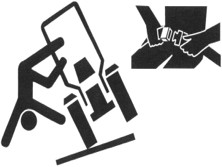
|
|
|
a,b,d |
|
|
a,b,c |
|
|
a,b,c,d |
| 10. |
Which one of the following are three types of tractor runover
- A passenger (extra rider) on the tractor falls off and is run over.
- The tractor operator either falls off the tractor as it is operating or is knocked out of the seat and is run over.
- A person who is on the ground near a tractor is run over.
|
|
|
a, and b |
|
|
a and c |
|
|
a, b, and c |
| 11. |
The tractor power take-off (PTO) stub is another major hazard. The PTO stub normally turns between 540 and 1,000 revolutions per minute (RPM). At this rate, the stub is turning from 9 to 17 times per second. A PTO master shield (A) protects a person from the PTO stub. Some tractors have PTO stub guards that fasten to the PTO stub.
All tractors should have a PTO master shield to protect the tractor operator and helpers.
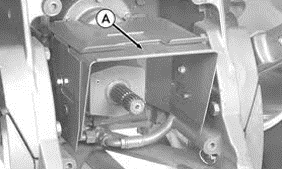
|
|
|
True |
|
|
False |
| 12. |
On a two-wheel drive tractor, CG is generally about
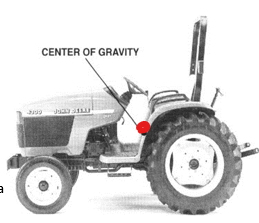
|
|
|
10 inches above and 12 inches in front of the rear axle. |
|
|
30 inches above and 60 inches in front of the rear axle. |
| 13. |
A tractor, including the drawbar, is designed to safely counteract the rearward tipping action of pulled loads. When loads are attached to a tractor at any point other than the drawbar, the safety design of the tractor for pulling loads is defeated.
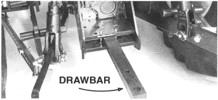
|
|
|
True |
|
|
False |
| 14. |
The heavier the load and the higher the "angle of pull," the more leverage the load has to tip the tractor rearward.
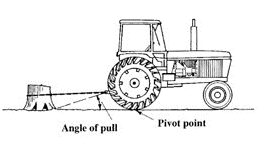
|
|
|
True |
|
|
False |
| 15. |
Which one of the following could be suggested for a safe tractor mounting?
- Keep the operator platform free of tools, equipment, mud or other debris.
- Use handholds and steps as you mount the tractor. Try to keep three points (two hands and one foot or two feet and one hand) on the tractor at all times.
- Adjust the seat and steering wheel (if necessary).
- Adjust and buckle the seat belt (if the tractor has ROPS).
- Check the major controls (PTO, hydraulics, gearshift stick) for the neutral (or PARK) position.
|
|
|
a, b, and e |
|
|
a, b, and c |
|
|
a, b, c, d, and e |
|